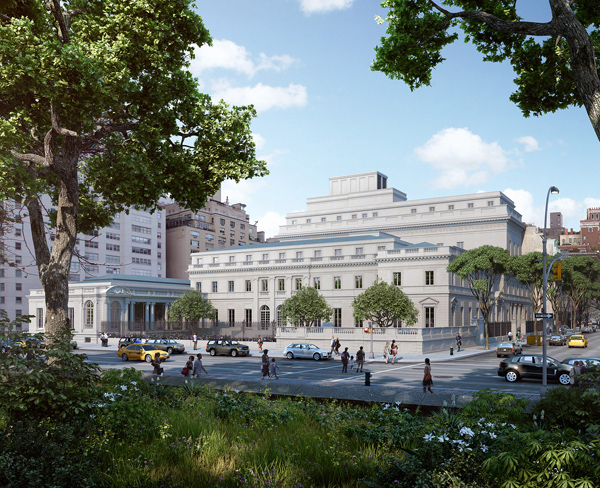Recently, an ill-considered op-ed in the New York Times, written by David Masello, took issue with the Frick Collection’s plans for an ambitious expansion. Yes, there is something formulaic, almost knee-jerk in the way in which, these days, every museum seems to feel that it must expand and debase itself to embrace bigger audiences. But there is something equally formulaic, almost knee-jerk, in supposing that the Frick Collection is animated by no wiser impulse than simply to follow the trend, that it is “doing” a MoMA or a Whitney. If ever a museum were justified in expanding, it is the Frick, especially in expanding exactly as the Frick intends to do.
Mr. Masello’s argument can be reduced to the fear that this expansion will destroy the sense one now has, in visiting the Frick, of entering one of the great private residences of the Gilded Age, that the expansion will ruin this effect through the introduction of stridently modern forms like those of Renzo Piano at the Morgan Library or through the overblown maximalism of what the Museum of Modern Art has become.
But there are several reasons why such fears appear unjustified. First, the Frick that one sees today is in two respects different from the home that Henry Clay Frick inhabited and that was completed exactly a century ago, in 1914. First, the structure one sees today is double the size it was in Frick’s lifetime, due to John Russell Pope’s design of the peristyle courtyard, the auditorium, and two of the major galleries, not to mention the entrance pavilion-which in Frick’s day was outdoors. As for the ticket area and external garden, those were added in 1977.
 As importantly, nearly half of the building that existed in Frick’s lifetime, and that exists today, has never been seen by the public: I refer to the second-floor spaces, above the cordoned-off view of a pipe organ, which is as close as the public ever comes to the upper stories. But the spaces that lie concealed, and the art they contain, would be an impressive addition to any museum, and the planned expansion would open them to the public for the first time.
As importantly, nearly half of the building that existed in Frick’s lifetime, and that exists today, has never been seen by the public: I refer to the second-floor spaces, above the cordoned-off view of a pipe organ, which is as close as the public ever comes to the upper stories. But the spaces that lie concealed, and the art they contain, would be an impressive addition to any museum, and the planned expansion would open them to the public for the first time.
The grand staircase, the Frick Collection, New York; photo: Michael Bodycomb.
Also, the expansion is to be designed and overseen by Davis Brody Bond, which has exhibited in the past a great sensitivity to historical context. As it happens, one of the main components of the Frick, its outstanding art reference library, is accessible only by leaving the building and walking around the block to 71st Street. Under the new plans this area would be accessible from the main entrance for the first time, thus creating a greater sense of unity and coherence than one finds today. That sense of unity, to judge from the public renderings, would be further enhanced by the form, massing, and classical language of the addition, which would rise just to the east of the existing structure.
Most importantly, perhaps, we must recognize that the Frick’s mission has changed significantly over the past ten years. Whereas it used to offer only a visit to its incomparable and changeless permanent galleries, it has recently begun to offer temporary loan exhibitions, as many as three simultaneously. Some of these have been among the best things on view in Manhattan at the time. But one has often had the sense that the museum has been pulling its punches, scaling back its exhibitions to fit the all too limited and somewhat uninspiring gallery spaces in its basement. Now, for the first time, the Frick hopes to offer spaces that will be equal to the its admirable ambitions and to the considerable talents of its curatorial staff.
The Frick Collection * 1 East 70th Street * frick.org


 Top of second-floor landing in the former Frick residence; photo: Michael Bodycomb.
Top of second-floor landing in the former Frick residence; photo: Michael Bodycomb. Rendering of The Frick Collection plan from Fifth Avenue; Artist’s rendering courtesy of Neoscape Inc., 2014.
Rendering of The Frick Collection plan from Fifth Avenue; Artist’s rendering courtesy of Neoscape Inc., 2014. Elevation of The Frick Collection plan from 70th Street; Artist’s rendering courtesy of Neoscape Inc., 2014.
Elevation of The Frick Collection plan from 70th Street; Artist’s rendering courtesy of Neoscape Inc., 2014. Former bedroom of daughter, Miss Helen Clay Frick; photo: Michael Bodycomb.
Former bedroom of daughter, Miss Helen Clay Frick; photo: Michael Bodycomb.
 Former bedroom of Mrs. Henry Clay Frick; photo: Michael Bodycomb.
Former bedroom of Mrs. Henry Clay Frick; photo: Michael Bodycomb.
 Former second-floor study of Mrs. Frick; photo: Michael Bodycomb.
Former second-floor study of Mrs. Frick; photo: Michael Bodycomb.
 Second-floor corridor in the former Frick residence; photo: Michael Bodycomb.
Second-floor corridor in the former Frick residence; photo: Michael Bodycomb. Former Frick family breakfast room, located on the second floor of the former Frick mansion; photo: Michael Bodycomb.
Former Frick family breakfast room, located on the second floor of the former Frick mansion; photo: Michael Bodycomb.